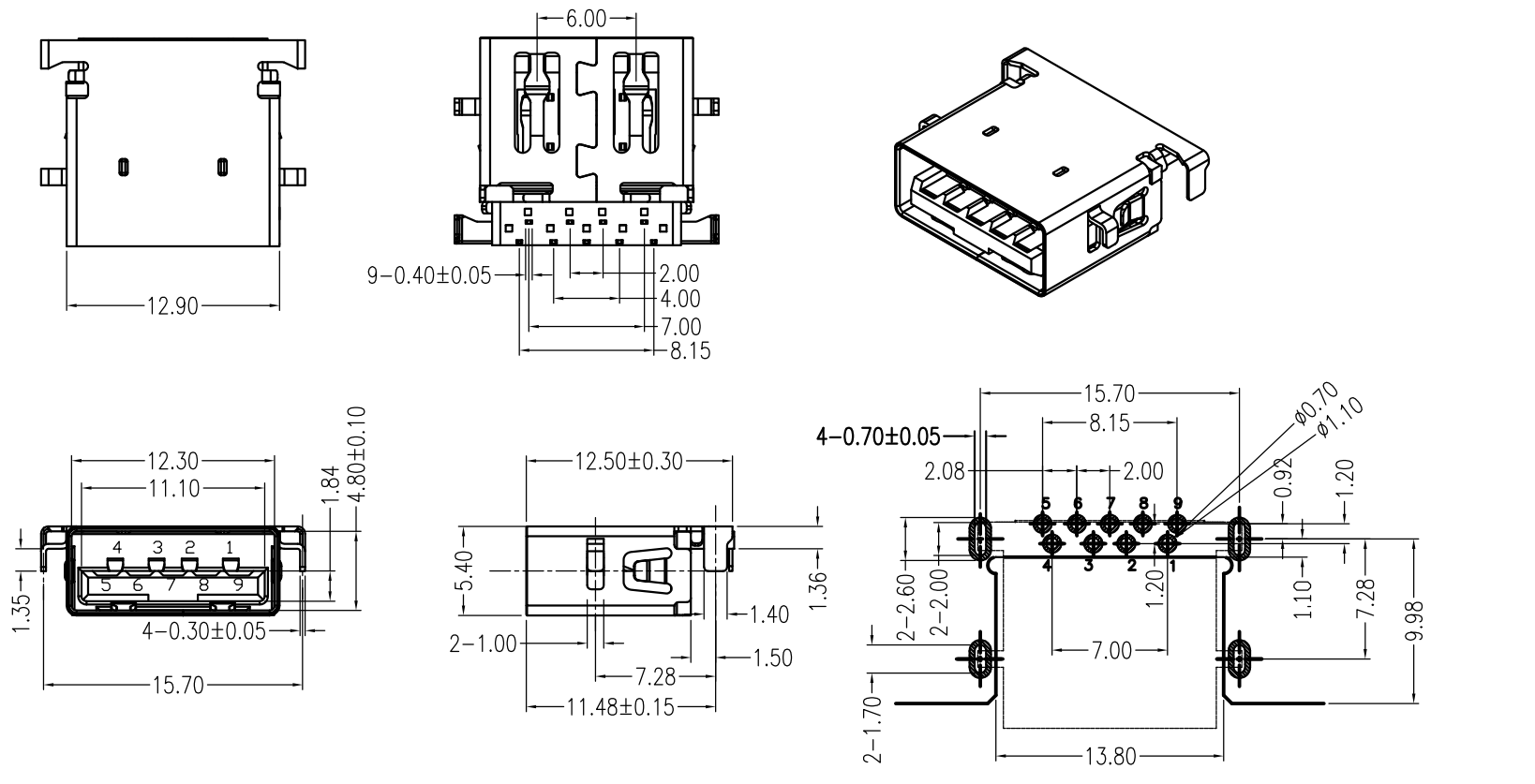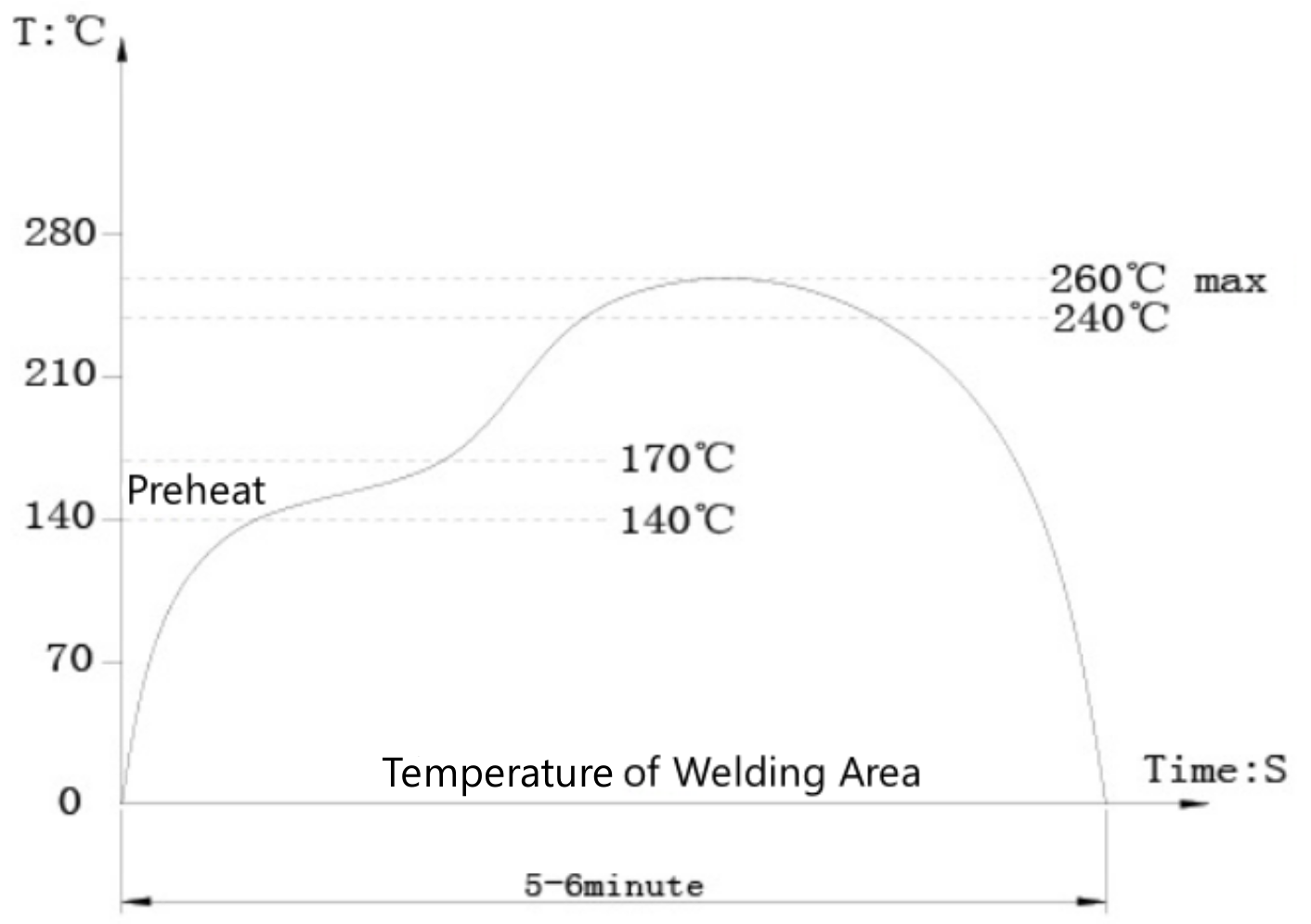


The USB 3.0-3682 is a high-performance, space-saving DIP connector ideal for compact electronic devices. It features a horizontal 90° DIP mounting design and 1.36mm reverse-side recessed structure, ensuring flush PCB installation and efficient component coordination.
Model Number: USB 3.0-3682
Dimensions: 12.9mm*12.5mm, compact for tight layouts
Pin Configuration: 9 pins (4 USB 2.0 + 5 USB 3.0 high-speed pins)
Data Speed: Up to 5Gbps (USB 3.0 standard)
Electrical Ratings: 1A/contact terminal, 30V DC; 30mΩ contact resistance, 100MΩ min insulation resistance, 100V DC dielectric withstanding voltage
Materials: Stainless steel/brass shell (nickel/tin-plated), gold-plated copper alloy terminals, high-temperature resistant LCP insulator
Mechanical Performance: ≤35N insertion force, ≥8N extraction force after testing; 5000+ mating cycles durability
The USB 3.0-3682 Reverse-Side Recessed DIP Connector is a high-performance electronic connection component designed for compact spaces. Its core features include a horizontal 90° DIP (Dual In-line Package) structure and a 1.36mm reverse-side recessed PCB mounting design. Below is a detailed introduction:
| Characteristics | Specification |
| Current Rating | 1A/contact terminal |
| Voltage Rating | 30V DC |
| Contact Resistance | 30mΩ |
| Dimension | 12.9mm*12.5mm |
| Dielectric Withstabding Voltage | 100V DC |
| Insulation Resistance | 100MΩ min |
Mounting Method: Adopts a horizontal 90° DIP design, allowing the connector to be mounted vertically on the PCB. This significantly saves surface space on the circuit board, making it ideal for electronic devices with strict space layout requirements, such as small portable electronic products.
Reverse-Side Recessed Structure: The connector features a 1.36mm reverse-side recessed design. When mounted on the PCB, its surface remains flush with the PCB surface. This not only facilitates tight coordination with other components but also enhances the compactness and aesthetics of the overall structure. Additionally, it reduces the risk of damage caused by collisions during transportation and use.
It has a compact size of approximately 12.9mm*12.5mm, which enables it to adapt to various specifications of PCBs and facilitates layout in limited spaces. Meanwhile, this size complies with relevant dimensional standards for USB 3.0 standard interfaces, ensuring compatibility with other USB devices.
As a USB 3.0 connector, it is equipped with 9 pins in total. These include 4 pins from USB 2.0: VBUS (Power Positive), D(Data Negative Line), D+ (Data Positive Line), and GND (Ground). Additionally, there are 5 extra pins dedicated to USB 3.0 to support high-speed data transmission. The reasonable arrangement of these pins guarantees stable and efficient signal transmission.
Generally made of metal materials such as stainless steel (e.g., SUS201) or brass, which offer excellent mechanical strength and wear resistance. The surface is nickel-plated or tin-plated, which not only improves the connector's corrosion resistance but also enhances its electrical conductivity, ensuring stable operation in various environments.
Typically crafted from copper alloy, featuring outstanding electrical conductivity. The contact parts are gold-plated to reduce contact resistance, improve the quality and stability of signal transmission, and enhance wear resistance and oxidation resistance. The soldering parts are tin-plated to facilitate welding with the PCB and ensure welding reliability.
Mostly uses high-temperature resistant LCP (Liquid Crystal Polymer) material, such as LCP(E130i). This material has excellent insulation performance, effectively preventing interference between signals. It also boasts high mechanical strength and heat resistance, maintaining stable performance in high-temperature environments and ensuring the connector's service life.
Supports the high-speed data transmission standard of USB 3.0, with a transmission speed of up to 5Gbps. This represents a significant improvement compared to USB 2.0, meeting the high-speed data transmission needs of most electronic devices, such as fast transfer of large-capacity files and videos.
The rated current is 1A per contact terminal, providing stable power supply for connected devices. The rated voltage is 30V DC, which meets the operating voltage requirements of most USB devices.
The contact resistance is typically no more than 30mΩ. Low contact resistance minimizes energy loss during signal transmission and ensures signal integrity. The insulation resistance is not less than 1000MΩ when unpaired and not less than 10MΩ when paired. Excellent insulation performance effectively prevents leakage and signal interference.
The dielectric withstanding voltage is generally 500V R.M.S., meaning the connector can withstand a certain degree of voltage impact. It offers high electrical safety and can operate stably in complex electrical environments.
The maximum insertion force is no more than 35N. The initial extraction force is not less than 10N, and the extraction force after testing is not less than 8N. The appropriate insertion and extraction force not only ensures the reliable connection between the connector and the plug but also facilitates plugging and unplugging operations for users, without affecting the user experience due to excessive or insufficient force.
It usually has excellent durability, capable of withstanding at least 5000 insertion and extraction cycles. This allows the connector to maintain stable performance during long-term use, reducing the risk of damage caused by frequent plugging and unplugging, and making it suitable for application scenarios that require frequent connections and disconnections.

KKG Electronics, each part of the use of temperature-resistant materials, high-temperature testing equipment 260 ℃ for 5 minutes, the appearance of the product does not change!

Leveraging its compact 90° DIP design, 1.36mm reverse-side recessed structure, and reliable performance, this connector is widely adopted across multiple high-demand sectors:
Consumer Electronics: Ideal for small portable devices such as mini tablets, compact Bluetooth speakers, portable chargers, and handheld game consoles. Its space-saving design fits tight internal layouts, while stable 5Gbps data transfer supports fast file syncing and efficient charging.
Computer & Peripherals: Used in slim laptops, all-in-one computers, and compact external storage devices (e.g., portable SSDs). It enables high-speed data transmission between devices and peripherals, and its flush PCB mounting adapts to thin device casings.
Automotive Electronics: Suitable for in-vehicle devices like dash cams, compact car chargers, in-car infotainment system modules, and tire pressure monitoring sensors. It withstands vehicle vibration and temperature fluctuations, ensuring stable power supply and data communication.
Industrial Control Equipment: Applied in embedded systems, compact data loggers, industrial sensors, and miniaturized diagnostic tools. Its robust metal shell and high insulation performance cope with harsh industrial environments, guaranteeing long-term reliable operation.
Security & Surveillance Devices: Fits small-sized surveillance cameras, wireless doorbells, and portable monitors. The space-saving design integrates seamlessly into compact device housings, while fast data transfer supports real-time video transmission and storage.
Medical Devices: Used in portable medical monitors (e.g., blood pressure monitors, pulse oximeters) and miniaturized diagnostic equipment. It meets strict electrical safety standards, ensuring stable power and accurate data transmission for critical healthcare applications.
Short USB Type-A connectors may encounter the following common problems during use:
Device not recognized or connection failed: When the USB connector is inserted, the computer or device does not respond at all, and the external device (such as a USB flash drive, mobile hard drive, or mobile phone) cannot be recognized, or an error message "USB device not recognized" is displayed. The reasons may include physical connection problems, such as poor contact, damaged connectors or cables, or foreign objects in the interface; driver problems, such as the device driver not being installed, being too old, or conflicting; system setting failures, such as the USB service being disabled or the USB function not being enabled in the BIOS; and insufficient power supply, where the device's power consumption is too high, exceeding the power supply capacity of the USB interface.
Abnormal data transmission or slow speed: When transferring files, the speed is much lower than expected (for example, the transmission speed of a USB 3.0 interface is only at the level of a USB 2.0 interface), or transmission interruptions and file corruption occur frequently. This may be due to USB version mismatch, where the device and the connector support inconsistent USB protocols; interface or cable aging, where long-term use causes oxidation of the interface and breakage of the internal wires of the cable; system performance bottlenecks, where high CPU and memory usage on the computer affect the data processing speed; or device - specific problems, such as bad sectors or poor performance of the external device (such as a USB flash drive).
Abnormal charging or no charging: When devices such as mobile phones and tablets are charged through a USB connector, it may display "slow charging", "not charging", or fail to charge at all. The reasons may be that the power adapter has problems, such as the output voltage/current not meeting the standard or the adapter being damaged; USB PD protocol incompatibility, where the fast - charging protocols supported by the device and the charger are inconsistent; interface or cable failure, such as internal wire breakage or loose interface causing poor contact; or device hardware failure, such as a damaged mobile phone tail - plug or an aging battery.
Loose interface or poor contact: After the USB connector is inserted into the device, it is easy to fall off, or slight shaking will cause the connection to be interrupted. This is usually due to physical damage to the interface, such as deformation and wear of the interface metal shrapnel caused by long - term plugging and unplugging; connector design problems, where the size and tolerance of non - original accessories do not meet the standards; or external force effects, where the device interface is impacted or overly bent.
Compatibility issues: Some USB connectors may be incompatible with devices, resulting in failure to be recognized or work properly. This may be because the connector specifications do not match, or the device does not support the connector's version.
Overheating: The interface may overheat, which may be caused by high - current transmission or excessive contact resistance. In this case, the connection should be disconnected immediately, and it should be checked whether the cable and the device are short - circuited. If necessary, the accessories should be replaced.
Previous: Short USB 3.0 Connector

Tel:
Add:
Rixing Industrial Zone,Tangxia Town, Dongguan City, Guangdong Province, China
Copyright © 2025 KKG ELECTRONICS ELECTRIC Co., LTD. All rights reserved
Privacy policy Cookie tracking